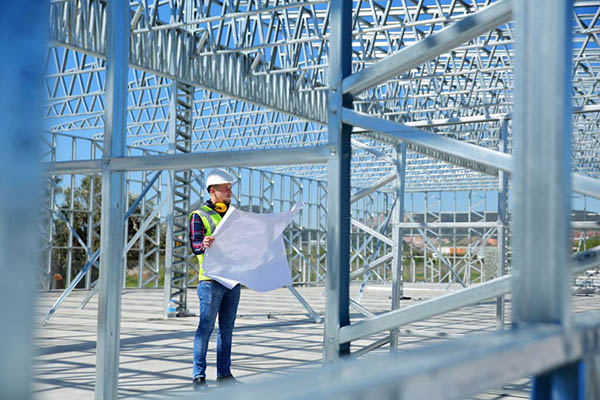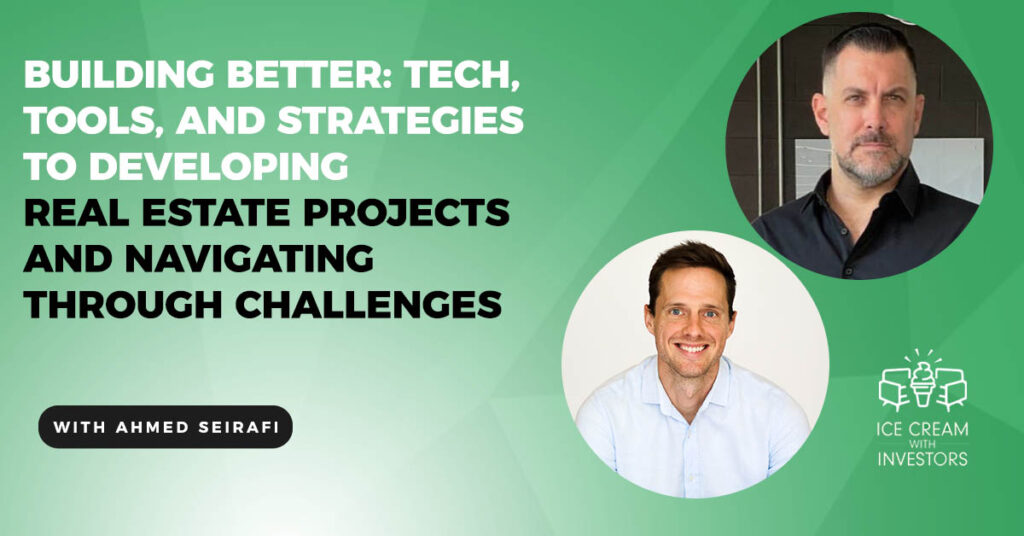Real estate is a complex and ever-changing industry, and building better requires more than just transactions. It’s about embracing the bid process, leveraging specialized tools and technology, and navigating the challenges of decision-makers who may not fully understand the process. In this episode, Ahmed Seirafi, founder of Ahmed Builds Better, shares how to bring passive and active real estate dreams to life. He shares his real estate journey and how he discovered the value of the bid process, long developmental process, and more. Ahmed also shares the tools, tech, and strategies he learned along the way that can help navigate through the challenges in real estate. Ahmed shares that with the right mindset, knowledge, and tools, we can achieve our real estate goals, reach financial freedom, and build everything better. Tune in now and learn how you can build better, too.
Are you interested in investing with me? Click this link to schedule time for us to connect. https://nextlevelincome.com/next-level-investor-club-application/
Discover Ahmed Builds Better: Website | YouTube | LinkedIn | Instagram
—
Watch the episode here
Listen to the podcast here
Building Better: Tech, Tools, And Strategies To Developing Real Estate Projects And Navigating Through Challenges With Ahmed Seirafi
Ahmed, welcome to the show.
Matt, how are you doing?
Fantastic. How about you?
I’m doing well. It is another cloudy day in Southern California.
You don’t get too many of those, do you?
No, but I appreciate them.
We like to start with the difficult questions here. What is your favorite ice cream?
My favorite ice cream is anything with caramel in it. It used to be the mint chip, but I have matured into anything with caramel.
My ice creams go in seasons. I am in a caramel phase now. Anything with caramel, I agree.
It is sophisticated.
You are in the Inland Empire in California. If we are in that area, do you have a favorite ice cream shop that you could recommend?
There is nothing that sticks out. There is one place called Handel’s, which is a local home mom-and-pop establishment with a couple of locations. They make everything in-house. Beyond that, there is nothing craft that sticks out in any way whatsoever.
Making ice cream in-house is a niche there. Tell our readers, what is the scoop? What do you do now?
I’m a Southern California base real estate investor and developer. I focus on large-scale, multifamily investments and developments, as well as small to medium size industrial warehouse logistical-type buildings.
Where did your real estate journey begin?
Many years ago, I graduated from college. I was going to continue working in the family business, pumping gas at my dad’s gas station. That didn’t work out. We had a falling out at the time. I went out and looked for a career. A professor of mine who had a real estate investment development company suggested commercial real estate. He said, “You will be good at it. You will enjoy it.” I went in that direction.
I got a job working for a company called CB, which is CB Richard Ellis, back in the day. It is a large commercial brokerage firm doing industrial and office representation in Southern California. I did that for a few years, left the company, went out on my own, and did that for a little bit longer. A few years after that, I started working for a friend with the aspect of taking over his company and his business because he wanted out. He was doing large-scale public contracting, building high schools, colleges, and universities. Anything that had public money related to it, he was a contractor.
I was a part of many teams, large developments, and large construction projects, things that were $500,000 up to $150 million in nature in terms of a construction project. I got a lot of construction experience. I’m working with the family, investing and developing along the way. I have taken it full circle. I’m pursuing investment and development full-time as a career, company, and family office.
Before we get into the development piece, take me back to CBRE because you might be the first person I have had on the show that’s worked at a major firm like that. What is that like? Were you in sales? If so, were you targeting investors, properties, and owners? What did that look like?
After my initial training with a couple of different specialties within the company, they put me in asset valuation, property management, appraisals, industrial and office sales, and leasing. After I had done my training with them for a year, I went full-time into the industrial-type product category, meaning I was an industrial broker. In all those big warehouses that you see throughout Southern California, I was representing tenants, buyers, sellers, developers, and everything in between. My focus was industrial buildings, these big concrete boxes you see everywhere.
It was almost like a boiler room where you were constantly cold-calling, whether on the phone or door to door with your business card and a flyer, back in the day. They didn’t have the social media marketing, the advertising, the direct mail campaigns, and the email campaigns they have now. It was either you were on the phone or going door to door knocking on a door with a flyer and a business card looking for a business.
What did you think about that role? It sounds tough. I would put it that way.
It was tough. I excelled at a certain aspect of it because of the skillsets I had. I was good at finding an opportunity, seeing an opportunity, or finding a deal. I was good at rainmaking. I wasn’t the best closer, and even though I could close a deal, I wasn’t the best. My biggest skillset or my superpower was finding those opportunities and bringing them into the company, so other partners in the group or the company and I could go and close those deals. It was a lot of work. You start refining your skillset, and you are able to double down on what you are good at and go after it.
When you start refining your skill set, you are able to double down on what you are good at and go after it.CLICK TO TWEET
Do they segment it out by niche? You were with industrial, or could you call on multifamily and retail?
They wanted you to follow your niche because you would be a mile wide and an inch deep if you were doing that. You will be going after all these different types of tenants. If I ever had a deal that would come into me through a referral, a friend, or a contact that wasn’t in my specialty, meaning industrial and some office work, I would refer it out to another broker in the office, like, “This is a retail deal. It came through my network. I’m going to refer it to you. This is a multifamily opportunity. It came through my network. I’m going to refer it to you. If you are able to close the transaction and get a deal, send me a referral my way.” That is what it was, but they wanted you to specialize in your product type.
You move over into the government buildings. We will call them schools. I think I I heard that correctly. Were you all doing that across the country? What did that business look like?
That was mostly here in Southern California. After I left CB, I was brokering for a while on my own, I still do to this day. I still receive a lot of business, and I refer out to people. We were a contractor and subcontractor working on a lot of these public projects. Whether it was a culinary school, an office building for the district, a new high school, or a remodel of an existing school or city hall, we would go out and bid on these contracts or these opportunities through the bidding system because we were a union contractor. These types of government opportunities had to go to contractors that were union, or they paid at the prevailing wage. We were a union contractor, meaning all our labor was union. We would go after all these public-type opportunities.
That helped separate you from any other bid out there because you bit the box they were looking for.
We are a union contractor, or you are prevailing wage. A lot of private contractors did not want to pursue that type of business. They didn’t want to deal with the payroll requirements and the reporting requirements. The other requirements necessary to go after public work, a lot of them didn’t want to do that. They stuck the private worker or private jobs. That is why another company like ours went after the private work.
How did you make that mindset shift? It sounds like one was more transactional and based. You are going out there and hunting. You are eating what you kill. When the deal closes, you are going to get paid. Now you are moving over into a bid process, which is a long development process. Once you close a bid, you have to complete the project before you start dripping in cashflow.
As a contractor, you got paid along the way. If you were to win the bid, you would start putting together your materials, teams, and schedules. You would start billing along the way. Meaning, “I showed up on the job. I brought all my equipment. I brought all my tools. Here is the first set of billings that you need to pay me.” Every two weeks, I would submit billing again. I’m like, “We brought more material and equipment. We have completed more of the project. Please pay us again.” We would get paid along the way. It wasn’t like you had to wait until the end of the job or anything like that.
What they did was they did something called performance billing, where they would go and double check your performance of the contract. Meaning, “I’m billing for 16% of the job now because I feel like I have completed 16% of the work.” They would go out and double-check that to make sure that you weren’t overbilling them or you weren’t trying to do anything wrong. It is a good process or skillset to have for any real estate project. It is performance billing. Whether you are a contractor, you trust him or not. If they are asking for 16% of the contract, you need to go and double-check that.
I don’t think I have talked about it on the show often, but my dad is a steel building contractor. He is out there bidding on projects. If he wins a project, he finds a team. He puts it together, and they start building. I remember early on in my life. I was in early high school, where he had that moment of clarity shift around like, “I need to be getting paid along the way.” What does that look like? Did you have specific metrics that you are hitting along the way? Is it on a job-by-job basis?
It is job by job. It wouldn’t be any specific matrix, but it would be like when you do your budget thing, and you do your analysis and stuff along the line, it is like, “If I’m billing for 16% of the work, in that 16% of the bill or the invoice that I give submit to them, I know there is 16% of labor, materials, and my office and my administrative staff in there. There is 16% of the profit already built into that and 16% of my overhead is already built into it as well.” You are not getting reimbursed for 16% of the work. You are getting paid for 16% of that contract, including your profits and your overhead.
You have to make sure that when you do your budgeting, billing, and forecasting, all this is included along the way because you don’t want to bill and receive a check. It only covers your labor and materials. I got an office, rent, trucks, insurance, gas, office staff, and all these other things that I needed to pay for, but it wasn’t a part of that billing. It is something you have to get a little bit more technical about. This is why a lot of contractors struggle because of the inability to understand the billing process.
What does your tech stack look like for that? Are you running all this out of an Excel spreadsheet? Do you have some specialized tools or technology that you use to help?
I’m not in the business anymore, but there is a lot of technology, apps, and software. You can do things like that where you can put in your budget, performance, and costs that you have occurred. It will forecast and will budget for you. There are different ways of doing that. When I was doing it years back, we are doing it on a spreadsheet, “This is where we are. These are our costs. These are the percentages. This is what we need to add in. This is going to give us the total amount we need to build forward or the minimum amount we need to receive to keep the doors open until we get paid off at the end.”
Let’s hope we don’t miss a decimal point along the way.
It has happened, for sure.
Take us to what you do now. You mentioned you are looking for industrial space and larger multifamily land to develop. Talk us through a little bit about that process.
I have come full circle. I am focusing 100% of my time on investing and developing. I was doing that along the way for the last several years, but this is now going full-time, 100% into that business. What I do is I focus on investing in multifamily property existing, which is 100 units plus, in about half a dozen states across the country that I have identified as being states that I want to be in or metropolitan areas that fit my metrics. We are developing multifamily property, 100 plus units across the country in certain areas that I have also identified. I have two projects that are about 300 units a piece. One is going through plan revisions. Another one is we are moving dirt on it out in North Dallas.
Along the way, I look for small industrial property, meaning industrial development opportunities, and 1 to 3 acres. These small inflow pieces that a lot of the larger developers pass up on. It is small for them to fit into their buy box, but it is perfect for me because I can buy 1, 2, or 3 acres, pay all cash, develop a building or multiple buildings on that property, sell it, and roll that money into the larger multifamily developments and investments I am pursuing.
Do you care to name the six states that you are looking in? You mentioned about half a dozen states.
California is on there, not because I have identified it, but because I’m here. It is my backyard. It is not an easy place to do business, but I’m here. I was born and raised. I know the area. We got California, Arizona, Texas, Georgia, Tennessee, Florida, and Nevada.
It is the Sunshine States or the Smile States that they talk about a lot.
A lot of people do it for the business aspects of it because of the weather or the long term. I do it because it is a similar climate and demographics to where I am in Southern California. I get sun, certain types of income, and tenants. It is a similar market or geographic I’m already used to because of being born and raised here in Southern California. I’m not going up to Upstate New York or Minnesota because I don’t understand those markets, whether it is the climate or the business aspects of it.
How are you finding a couple of acres, infield lots? Are you going through traditional brokers? Do you have feet on the street? What does all that look like?
There’s a little bit of everything. I do have brokers that bring me opportunities. I find a few of them myself. One of my superpowers or strengths was being able to spot an opportunity. I’m constantly driving, taking a different road, and keeping my eyes open for these things that most people may skip or pass up on. I find it as an opportunity.
Develop the strength to spot an opportunity. Drive constantly, take a different road, and keep your eyes open for these things that most people may skip or pass up on. Find it as an opportunity.CLICK TO TWEET
I have closed escrow on a second parcel. I’m going to go into escrow on a third parcel here in the Inland Empire. These parcels are small parcels that most developers or investors would pass up. I saw them as an opportunity to say, “If I can assemble all four of those parcels, I can have one large parcel. That would be a great development opportunity.”
I’m able to stretch along that escrow for twelve months because I’m assembling 3 or 4 different parcels. I’m dealing with 5, 6, and 7 different buyers. I’m able to be flexible, unlike some of the larger companies and developers who are less flexible. They have to follow a certain procedure. I’m able to bob and weave when the troubles or the situations demand it.
I would think in your own backyard, where you know some of the political climate, zoning, or regulations, it would be easier to navigate through those situations. When you start reaching into other states, I would imagine there is some difficulty there. Can you talk us through, like, if you are developing in the Inland Empire and all of a sudden, you get to Georgia, some of the differences in how you go through the zoning process or get plans approved and things like that?
It is a lot easier in a lot of other states than California.
I was thinking, “If you could do it in California, you could probably do it about anywhere else.”
All this gray is from the technical planning department and planning commissions. California is rigid, not business-friendly, or contrary to what they say, “We are business-friendly. A lot of people are living here. We need to provide a lot of housing. We need to do something.” When I show up, I say, “I want to be a part of that. I want to build some apartments and townhomes.” They make the process difficult because, unfortunately, California has adopted a policy.
They were like, “We are going to let everyone have a say and opinion and put their two cents in.” They may know nothing about real estate development, planning, construction, demographics, needs, forecasting, and finance, but they allow everyone to be a part of that. When they allow everyone to be a part of that, it completely muddies the whole process, and it stretches.
In other states, such as Texas, they understand, like, “We need housing and opportunities. We need this in our area. We are going to help you process this. We are not going to let everybody have a say, everyone slows down the process, and everyone raises an objection or a comment. We are going to help you through the process to get this done quicker because we understand this is needed.”
I had one project, and we had a community meeting where we invited the community out to give the two cents. It was part of the rules. You had to do that. You had to have the community meeting. The community showed up. They didn’t say anything about the project, but everybody wanted to come and gripe. They said, “What about the homeless? What about the traffic? What about the signals? What about the potholes?”
Everything that didn’t apply to my project, people were out complaining and griping about it. It sets the stage for doing business here in California. They allow everyone to have a say, whether they are related to the project or not. They take all that into their accountability. It muddies the waters and slows things down tremendously.
When you have people in the planning department, the city councils, or anything of authority, and they don’t understand real estate, development, forecasting, or demographics, but they are in positions to make decisions, you can see that a lot of those decisions slow down because they don’t understand the process. The right people are not in the right jobs. That is unfortunate, but that is where things are sometimes.
When people are in positions to make decisions but don’t understand real estate, a lot of those decisions slow down because they don’t understand the process. The right people are not in the right jobs. That is unfortunate, but that is where things are…CLICK TO TWEET
How do you, as a developer, navigate through that? There are two separate challenges. There is 1) The community aspect of it, and 2) Educating the lawmakers on what is needed and why. How do you navigate through those situations?
It is a lot of navigating and educating. When I come up with a project, opportunity, or development, I need to make sure all those questions are already answered and any objection has already been attended to. I need to make sure that no matter what someone says, I have already had it covered. One of my projects is 300 unit apartment complex. I’m redesigning because of a change in the market and the demographic. That project will bring in additional traffic. It will bring in an additional this and that.
What happens is I make sure that it is already mitigated by the time it gets there. They were like, “It is going to bring in a lot of traffic.” I’m like, “No, because I have already done a traffic study. We are going to make these changes to the street. We are going to provide additional driveways so people can get in and get out easier and doesn’t cause any traffic problems.” They are going to be like, “This big project is going to be bright. The neighborhood is going to be complaining because there is so much light.” I’m like, “No, we already did a photometric study saying that where we are placing the lights on this project will not bleed into the surrounding neighborhood and bother other people.”
You got to make sure that you are bringing something that is needed to the community and area, but you have to have all those questions answered in advance because everyone is going to ask questions. They won’t have answers, but you need to have those answers. The sooner you have those answers, and the sooner you are prepared, your project is going to move along a lot easier.
I’m going to show my ignorance in this. To be transparent, I have never developed a multifamily unit project or anything like that. We are on the same page. Is there a centralized turnkey service out there that comes and does traffic studies, photonic studies, light studies, and all this stuff? Is that each individual consultant that you are going down the list to find?
You can do it in different ways. As a developer, you are the project manager, or you may have a project manager in-house. It is their job to take all these individual pieces needed for the submittal process. They put it together and submit it. A lot of times, your architect or engineer could take the lead on these things.

Building Better: As a developer, you are the project manager, or you may have a project manager in-house. It is their job to take all these individual pieces needed for the submittal process. They put it together and submit it.
You can include that in the contract saying, “Mr. Architect, Mr. Engineer, you are the lead on this project. I’m going to request that you do all the studies and manage all the third-party reports. You bring everything to the table that is required for full submittal. I will pay you as a part of your contract. Do that, or I can do that myself.” You can go two different ways about it, depending on how much time and effort you want to put into it.
The 300 units you are building in North Dallas, can you talk to us a little bit about that? Is it an A class or a B class? Any mixed uses in it? Talk to us a little bit about that.
This is a great project. I’m excited because we are already moving dirt on it. I bought the land in early 2022. We closed escrow a few months ago. This was a friend of mine who I met through my real estate groups. He called me and said, “I have this opportunity for development. Would you be interested in that and take a look at it?” I was like, “Yes, let’s do this. Let’s partner up and make it happen.”
I executed the contract, bought the land, and now we are pursuing all the approvals. We have already received the entitlements, meeting, and permission to go and build the product. All we are doing right now is doing the construction documents and getting those approved. Once those are approved, we can put a shuffle on the ground. That project is in North Dallas in a city called Anna, which is North of Frisco, McKinney. After that, you go up a little bit north to Anna, which is on the path of growth.
It is a 90-acre project. We have 288 townhomes for rent planned for this property, meaning it is not going to be townhomes for sale or rent. We are giving people the next move from living in a 1 or 2-bedroom apartment, and they are going into a 2 or 3-bedroom townhome with an attached garage, which is the path of growth for a lot of people.
This product type is the most demanded product in the country, which is the build for rent. Multifamily for rent is always hot, but this is the new build-for-rent model. We got 288 townhomes. We have already moved the dirt, received our entitlements, and a huge valuation on the land by creating value by going through the entitlement phase. All we are doing now is getting those construction documents done. We can start going vertical here soon.
What is the extra strategy here? Will you keep that product in-house, or will you build it and sell it off?
If I’m out building my apartment complex here in Southern California, I have two of them that we are pursuing, 300 units. That is one project, escrow, mortgage, or refinance. If I’m building for rent products and townhomes, and I’m building 288 townhomes, I’m going to have a condo map or have something in the legal document saying these are all individual units part of a larger project.
My exit is multiple. I can go and build that 288 units and keep them. I can go and sell half of the lots to another developer. I build half, and he builds half. I can go and build the first phase, refinance it, build the second phase, sell the first, keep the second, and keep the third. There are multiple different options here because they are all on individual plots. As long as I keep all of the units in some general property management and keep everything uniform and the same, I can have multiple owners, exits, and investors. There is a lot of flexibility in it.
Will you make that decision when the development is nearing the end? When in the project life cycle will you start making that decision?
I will make that decision whenever an opportunity comes up to make that decision. Maybe I am halfway through development, and another opportunity comes up. I’m like, “That is a great opportunity.” What I do is sell half of my development or half of my lots. I take the money and do another opportunity. Maybe I build the whole thing, refinance, and take that out. Maybe I will build the whole thing and sell half. I sell it to another investor as an investment product. There are different exits on this thing, but I will not make a decision until that opportunity or that need presents itself.

Building Better: There are different exits for investors, but don’t make a decision until that opportunity or that need presents itself.
I had someone who said, “He who controls the dirt controls the deal.” This is a perfect example of you having multiple different exit strategies. You do control the fate of that project.
Whenever I get into development, I look for at least three exits from the time I get into it, and from the time it is complete, or I will break even, I will make money, or I will make a lot of money. I will not get into a deal if there is no exit strategy where I break even.
We have been in a choppy market over the past several years. We have had low-interest rates, high-interest rates, steady prices, and inflated prices. How do you de-risk a project like this with many unknowns out there?
What it is, is being able to build something in phases. My 300-unit apartment complex here in SoCal is being redesigned are three large buildings. I can build those in phases. I build the first one. My mortgage on that first building would be a lot lower, less than if I built all three. If I’m building the first one and leasing or occupancy is slow, the 2nd and 3rd one, I’m not going to go under construction until I get to a certain point.
Having multiple buildings, parcels, or exits is a way of reducing that risk. I have an industrial project here as well. In one of them, I have about a handful of them, but I have one where I’m building four buildings on it. Each building will have its own parcel. I can go and start building. Depending on the market, the demand in the area, or the product at that time. I can keep all four. I can refinance two and sell the other two. Keep one, and sell three.
By doing this, having them on different parcels and having different ownerships for each one, I’m able to be a lot more flexible when it comes to the market. Meaning, “I’m going to start building these things, but the economy is a little funny now. I’m going to build one. I’m in no need to build the other three. One is as much as the market will demand. I will build one. The other three, since they are separate parcels and separate buildings, I can build those at any time.” If I was building one giant million-square-foot warehouse, I got one option. Build it, or you don’t build it. You sell it, or you don’t sell it. You lease it, or you don’t lease it. You don’t have all these multiple exits on it.

Building Better: If you were building one giant million-square-foot warehouse, you have one option. Build it, or you don’t build it. You sell it, or you don’t sell it. You lease it, or you don’t lease it. You don’t have all these multiple exits on it.
You mentioned earlier that you would buy the land and cash on a particular project. Are you able to almost de-risk yourself because you own the land and cash and don’t have a debt service payment on it? What does that look like?
When I buy land, I make sure I have exits. I got to make sure I am buying land for below market at a certain percentage rate because if the market changes, I got to be able to exit it and break even. If I’m trying to buy something, I’m buying something that is hard to buy, no one wants, or has been passed over many times. I’m finding an opportunity to do something with it. I need to buy that thing for at least a good 20% or 30% less in the market because I’m going to take on the challenges of that property.
One property I have for sale is going to build. Because of the change in the market, it has gone from a great opportunity to a good opportunity. I’m like, “It is a good opportunity. I rather sell that property or that piece of dirt, break even on it, recapture my capital, go out, and find a great opportunity. I can still sell it and break even, even though land values have gone down.”
The developer I was talking through said his negotiation strategy was, “I can give you full price whatever you are asking for, but I’m going to need a twelve-month runway on this because I will have to go and get easements, approvals, and all that stuff, or you can sell it to me now for 70% of the market value. I will now hold that risk, not you, but I need some cushion there in case of a market downturn.” I don’t want to breeze over the fact that we were chatting about beforehand that you launched a new YouTube channel here. Could you name the YouTube channel and talk about the idea behind the YouTube channel? I was excited to hear about it when you were talking about it.
It is something that I have never seen, and I keep wishing it was out there. We all spend a lot of time on social media, whether it is YouTube, Instagram, Facebook, or LinkedIn. It is a format that I haven’t seen. I’m like, “How come this isn’t out there? This should be a great type of video to put out there because there would be a demand for at least me. If no one watches it, at least I’m happy with it.”
You can find it on my Instagram or YouTube, which is @AhmedBuildsBetter. It is simple. What I do is I will go out to different development projects throughout Southern California and the country. I will showcase that development project when it is just a hole in the ground. It is under construction or getting started construction.
How many times have you driven by and seen all this equipment, big cranes, or all this dirt being moved? You are like, “What is happening in my neighborhood? What is going on here?” I’m going to go out there, showcase that development and let you know what is going on. I will fly my drone, get the information, and tell you, “This is what is being built, who is building it, and why they are building it. This is the team behind it. This is what it is going to look like. This is how it is going to help the community. This is what it is going to do for the region.”
I’m going to show you what that hole in the ground is going to look like, what is going to come out of it, who is doing it, and why. It is going to be a development spotlight. They are quick videos, three minutes max for now. I’m giving you a quick overview of what is happening in your neighborhood and what is being built.
You are going to get upset with me after this. Nashville is a booming market now. I’m going to send you 50 different properties and be like, “Can you tell me what is going on with this?”
Episode three is launching in mid-January. I’m not sure when this episode will come out, but it is episode 4 or 5, which is Nashville. I was in Nashville in November 2022 for the annual R3 syndicate meetup, if you are familiar with R3 or not. What I did was I was going to come out to Nashville for this event and see all my friends, but at the same time, I’m going to look for a project to showcase on my upcoming YouTube channel. Episode either 4 or 5 is Nashville Yards.
I was wondering if you were going to drop the name of the project or if I had to get you offline to tell me what it is.
That is one significant project in Downtown Nashville. When I got into town, I counted the tower cranes. There are 6 or 7 tower cranes on that project. I’m like, “This is going to be the one I got to showcase.” I did a quick little three-minute video on that one. That will be episode 4 or 5.
It is a massive hole in Downtown that they are going to build. It will be a huge project here.
I’m going back to Nashville in February 2023. I will go and do a little update on it as well to see what has happened in the last several months.
No matter when the last time you visited Nashville, it is already changed since then. You will see some new buildings.
It is a great city. I love it.
I want to switch us now into our last round. We are calling this the Five Toppings. Our first one is, what is your favorite book? What is a book you have read that’s given you a paradigm shift?
I’m a big fan of business biographies. I love reading about the life and career of business visionaries. One book that I was a fan of was Made in America. It is all about Sam Walton, who created Walmart. It talked about his starting the business and how he went through the pieces of starting an opening and growing Walmart, which is the largest brick and mortar retailer in the world. Amazon is bigger, but they are strictly online. Walmart is brick and mortar. Being from Nashville, you are close to Arkansas, the home of Walmart.
It goes and talks about how Sam went to his competitors, how he evaluated the market, and how he did things to understand and grow his business in the right way. There are stories about how he goes into his competitors. He would walk the aisles and figure out, “Why is the soup in the back but the candies up front?” He would get down on his hands and knees with a tape measure. He will measure the width of the aisle. He was like, “My competitor’s aisles are four feet. How many aisles can I put into my store if I’m 3.5 feet or 4.5 feet?”
He does something that I am a fan of, which is breaking down anything into the smallest pieces, so you evaluate and understand it. People come to me and like, “How are you going to build a $100 million project? That is big and wild.” I’m like, “Yes, it is daunting. If you break it down to the smallest pieces, it becomes easy to do.” That is what I liked about the book Sam Walton: Made in America.
You are describing why I love business. It is because you could start moving little chess pieces around. If I made them three feet wide, could a cart still get down it? Yes. Would people feel comfortable? Yes. Now I can add two more shelves. I love the idea of you playing a chess game with it. Our second one is I believe that the person you become ten years from now is directly correlated to the things you do in the habits that you have every day. What are some of the habits that you have every day?
They are not good. People talk about getting up at 5:00 AM and taking a nice bath. That is not me. I wish it was. As I’m getting a little bit older in life, I am getting dialed in on my health. A lot of people are talking about biohacking and things like that. I know that we all have an end date sooner or later, but I want to make sure that by my end date, I’m in the best health I can be. I’m still functional, moving, and feeling good.
We all have an end date sooner or later. Make sure that by your end date, you’re in the best health you can be. You’re still functional, moving, and feeling good.CLICK TO TWEET
I don’t care if I’m 105 or 85. I want to make sure I feel good enough to be able not to be in a position where people have to take care of me 24/7. I want to be like, “He can live a good life. He is healthy and did his best at staying healthy.” Something important to me is dialing in my nutrition, supplements, activity, and exercise. That is something I want to do. Several years from now, when I’m 58, I want to feel like I’m 38 because I’m doing things the right way.
Our third one is, what is the best piece of advice you have ever received?
It is something I have learned, and I try to give it to other people. It is limiting beliefs. If I was able to take a step out of my body and look at me from a third person, I would be a lot further along in life than I am now. We have a lot of limiting beliefs in ourselves, and we don’t even notice it. If you are able to look at yourself objectively from a third person and understand and evaluate yourself, you are setting yourself up for success because you are not being blinded by the moment. You are looking at yourself from the third person in an unobjective way that allows you to evaluate and understand who you are so you can make those corrections for greatness.
Have you ever read The Gap and the Gain by Dan Sullivan?
No, I haven’t heard of it.
We will chat about it offline. It is a book that constantly reminds me to read and review because it talks about limiting beliefs and how we can overcome those.
I look forward to that.
Our fourth one is, what are you most proud of in your life?
Those limiting beliefs are coming off, and starting to make progress in my life in many ways, whether it is in my personal relationships, my professional business, or my health. It’s getting rid of those limiting beliefs, finally waking up and saying, “You could be doing much more. You could be feeling much better. You could be making much more of an impact versus being a recipient of what society gives you.” One of the greatest things is finally waking up and seeing all that is available to me and all the things that I can do.
One of the greatest things is finally waking up and seeing all that is available to you and all the things that you can do.CLICK TO TWEET
Our fifth one is if you could sit down and eat a bowl of ice cream with anyone, dead or alive, who would it be and why?
That would probably be Muhammad Ali.
Why?
It was because of his own self-belief in him being able to do whatever he puts his mind to and being humble about it at the same time. Him coming out saying, “I am the greatest. I am the best. I am going to go all the way to the top.” At the same time, being humble about it and open and caring to other people made me feel like he deserved that.
If I could sit down with him and understand his mindset behind it and understand, “How do you believe and understand that you are the greatest but at the same time, be humble, bring everyone along with you, and not have this greater than that attitude?” I would love to learn how to do that because you could apply that to business, personal relationships, and family by instilling, “You are the greatest, but we are also a team.”
He also gave it all up for something he believed in, like his stance against the Vietnam War, not going into the draft and getting thrown in jail, and removing his title. He is somebody that stood behind what he believed.
How many celebrities or athletes would do that nowadays?
There were a few celebrities that I remember when they died or passed because, honestly, I don’t know them. I see them on TV. I see a perception of them, but I don’t know them. I specifically remember Muhammad Ali dying and watching his funeral and the casket rolling through Louisville because it’s only two and a half hours away from me. I specifically remember that moment. I don’t think we have had anybody say him yet.
His personal beliefs are strong, but at the same time, he is humble, and you want to be his best friend. It is a great combination. I love it.
Ahmed, it is a fantastic conversation. I always love learning about development because it is something that I don’t know a lot about and have never done. It is always interesting for me to learn best practices from folks like yourself. If our readers wanted to reach out to you, follow the YouTube channel, or get in touch with more about what you do, where is the best place we could point them?
The best places would be three ways, Instagram, YouTube, and my personal website, which is going to be launching soon. Instagram and YouTube, it is @AhmedBuildsBetter. It is simple. Also, my personal website which will launch pretty soon as well.
Ahmed, thanks for coming to the show.
Thank you.
Important Links
- Ahmed Seirafi
- Handel’s
- @AhmedBuildsBetter – Instagram
- YouTube – Ahmed Builds Better
- Made in America
- The Gap and the Gain
- https://www.Linkedin.com/in/ahmed-seirafi-a0765a5/
About Ahmed Seirafi






